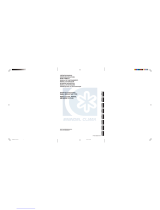
En-7
TIMER OPERATION
s
Before using the timer function, be sure that the Remote Control Unit is set to the correct current time (☞ P. 4).
To Use the ON timer or OFF timer
1Press the START/STOP button (Fig. 6 S)
(if the indoor unit is already operating, proceed to step 2).
The indoor unit’s OPERATION Indicator Lamp (green) (Fig. 3 5) will light.
2Press the TIMER MODE button (Fig. 6 Q) to select the
OFF timer or ON timer operation.
Each time the button is pressed the timer function changes in the follow-
ing order:
CANCEL OFF ON
PROGRAM(OFF → ON, OFF ← ON)
The indoor unit’s TIMER Indicator Lamp (orange) (Fig. 3 6) will light.
3Use the TIMER SET buttons (Fig. 6 W) to set the de-
sired OFF time or ON time.
Set the time while the time display is flashing (the flashing will continue
for about five seconds).
button: Press to advance the time.
button: Press to reverse the time.
About five seconds later, the entire display will reappear.
To Use the Program timer
1Press the START/STOP button (Fig. 6 S)
(if the indoor unit is already operating, proceed to step 2).
The indoor unit’s OPERATION Indicator Lamp (green) (Fig. 3 5) will light.
2Set the desired times for OFF timer and ON timer.
See the section “To Use the ON timer or OFF timer” to set the desired
mode and times.
About three seconds later, the entire display will reappear.
The indoor unit’s TIMER Indicator Lamp (orange) (Fig. 3 6) will light.
3Press the TIMER MODE button (Fig. 6 Q) to select
the PROGRAM timer operation (OFF ON or OFF
ON will display).
The display will alternately show “OFF timer” and “ON timer”, then change
to show the time setting for the operation to occur first.
●The program timer will begin operation. (If the ON timer has been se-
lected to operate first, the indoor unit will stop operating at this point.)
About five seconds later, the entire display will reappear.
About the Program timer
●The program timer allows you to integrate OFF timer and ON timer operations in
a single sequence. The sequence can involve one transition from OFF timer to
ON timer, or from ON timer to OFF timer, within a twenty-four hour period.
●The first timer function to operate will be the one set nearest to the current time.
The order of operation is indicated by the arrow in the Remote Control Unit’s
Display (OFF → ON, or OFF ← ON).
●One example of Program timer use might be to have the air conditioner auto-
matically stop (OFF timer) the operation after you go to sleep, then start (ON
timer) the operation automatically in the morning before you arise.
To Cancel the Timer
Use the TIMER button to select “CANCEL”.
The indoor unit will return to normal
operation.
To Change the Timer Settings
Perform steps 2 and 3.
To Stop Air Conditioner Operation
while the Timer is Operating
Press the START/STOP button.
To Change Operating Conditions
If you wish to change operating conditions
(Mode, Fan Speed, Thermostat Setting,
SUPER QUIET mode), after making the
timer setting and waiting until the entire
display reappears, then press the appropri-
ate buttons to change the operating
condition desired.
ss
t
To Cancel the Timer
Use the TIMER MODE button to select
“CANCEL”.
The air conditioner will return to normal
operation.
To Change the Timer Settings
1.
Follow the instructions given in the section
“To Use the ON Timer or OFF Timer” to se-
lect the timer setting you wish to change.
2. Press the TIMER MODE button to select
either OFF ON or OFF ON.
To Stop Air Conditioner Operation
while the Timer is Operating
Press the START/STOP button.
To Change Operating Conditions
If you wish to change operating conditions
(Mode, Fan Speed, Thermostat Setting,
SUPER QUIET mode), after making the timer
setting and waiting until the entire display
reappears, then press the appropriate
buttons to change the operating condition
desired.

















